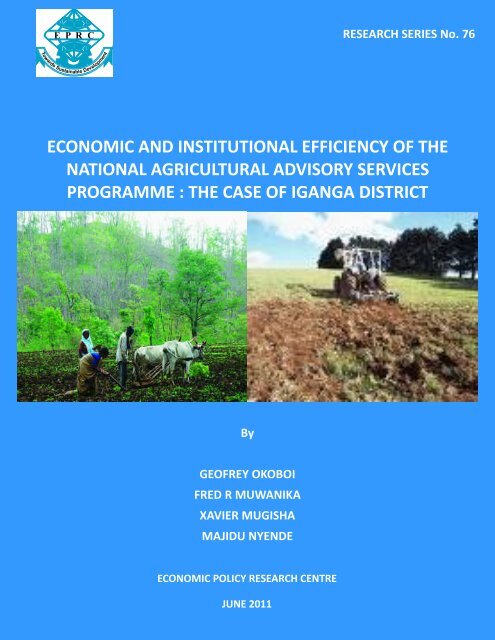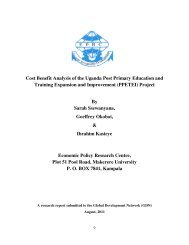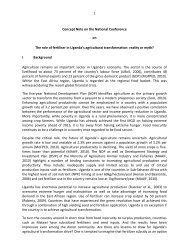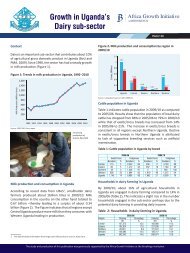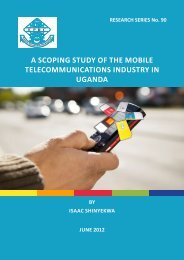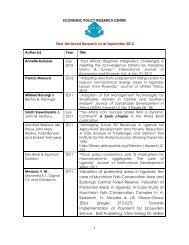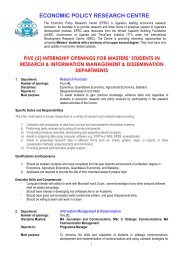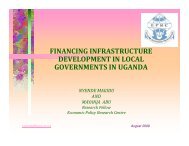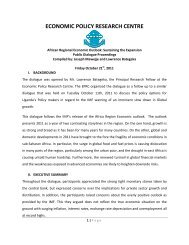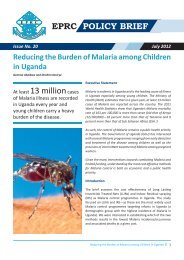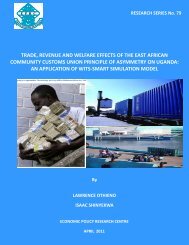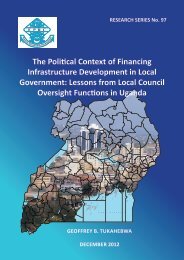the case of iganga district - Economic Policy Research Centre
the case of iganga district - Economic Policy Research Centre
the case of iganga district - Economic Policy Research Centre
- No tags were found...
Create successful ePaper yourself
Turn your PDF publications into a flip-book with our unique Google optimized e-Paper software.
Table <strong>of</strong> contentsAbstract ................................................................................................................................................. i1. Introduction .............................................................................................................................. 12. Overview <strong>of</strong> NAADS operations .................................................................................................. 43. Methods and data ..................................................................................................................... 63.1 Methods ................................................................................................................................... 63.1.1 Measuring efficiency ............................................................................................................................. 63.1.2 Analysis <strong>of</strong> efficiency determinants ...................................................................................................... 73.2 Data ......................................................................................................................................... 74. Results ...................................................................................................................................... 94.1 Descriptive statistics .................................................................................................................. 94.2 Efficiency .................................................................................................................................. 94.3 Sources <strong>of</strong> NAADS farmer production (in)efficiency.................................................................... 114.4 Institutional Efficiency ............................................................................................................. 124.4.1 Selection <strong>of</strong> farmers................................................................................................................. 134.3.2 Enterprise selection process ..................................................................................................... 144.3.3 Funding and utilisation <strong>of</strong> NAADS funds .................................................................................... 164.3.4 Flow <strong>of</strong> funds .......................................................................................................................... 174.3.5 Absorption <strong>of</strong> funds ................................................................................................................. 184.3.6 Procurement process <strong>of</strong> inputs ................................................................................................. 194.3.7 NAADS Monitoring and Evaluation System ................................................................................ 215.0 Conclusions and emerging issues .............................................................................................. 24References .............................................................................................................................................. 25ii
List <strong>of</strong> tablesTable 1: Iganga <strong>district</strong> administrative structure .................................................................................... 5Table 2: Possible results <strong>of</strong> cost effectiveness analysis .......................................................................... 7Table 3: Distribution <strong>of</strong> <strong>the</strong> sample farmers ........................................................................................... 8Table 4: Farmer characteristics ............................................................................................................... 9Table 5: Acreage, output, yield and gross pr<strong>of</strong>it <strong>of</strong> NAADS and Non‐NAADS Farmers ......................... 10Table 6: CE ratio <strong>of</strong> NAADS subsidy on yield value and gross pr<strong>of</strong>it ..................................................... 11Table 7: Stochastic frontier estimates <strong>of</strong> NAADS farmers’ revenue and gross pr<strong>of</strong>it functions ........... 12Table 8: Basic characteristics <strong>of</strong> NAADS farmer categories .................................................................. 13Table 9: Sample <strong>of</strong> enterprise combinations implemented in Iganga <strong>district</strong>, 2008/9 ........................ 16Table 10: Iganga <strong>district</strong>: NAADS budget, receipts and utilisation, 2008/9 .......................................... 17Table 11: Iganga <strong>district</strong>: Timeline <strong>of</strong> flows <strong>of</strong> funds from MoFPED to NAADS, 2008/9 ...................... 17Table 12: Iganga <strong>district</strong>: Absorption <strong>of</strong> NAADS funds, 20089 ............................................................. 19Table 13: Iganga <strong>district</strong>: NAADS tendering process in Nakalama sub‐county ..................................... 20Table 14: Iganga <strong>district</strong>: Comparison <strong>of</strong> open market prices to NAADS price <strong>of</strong> inputs, (Shs) ........... 21Table 15: Iganga <strong>district</strong>: Implementation, monitoring and results‐monitoring system in NAADS ..... 22Table A 1: Summary <strong>of</strong> government funding <strong>of</strong> NAADS Activities in Iganga <strong>district</strong>, (‘000 Ushs) ........ 27Table A 2: Iganga NAADS farmers by category, 2008/9 ........................................................................ 28Table A 3: Average <strong>of</strong> inputs provided by category <strong>of</strong> farmers in Iganga <strong>district</strong>, 2008/9 ................... 28Table A 4: Monitoring and evaluation budget and expenditure, 2006/7 (‘000 Shs) ............................ 29Table A5: Loan access and utilisation by farmers in Iganga District ..................................................................... 30Table A 6: Range <strong>of</strong> amount received (Ushs)........................................................................................................ 30Table A 7: loan Term ‐duration............................................................................................................................. 30iii
In <strong>the</strong> course <strong>of</strong> NAADS implementation, <strong>the</strong>re have been changes in its operationalguidelines. In <strong>the</strong> original guidelines, NAADS was mainly to support farmers workingtoge<strong>the</strong>r in groups to access advisory services from contracted agricultural advisors; developand multiply agricultural technologies at <strong>district</strong> and sub‐county level; and access markets(MAAIF 2000). With time, <strong>the</strong> original guidelines have been revised leading to changes in <strong>the</strong>implementation. For example, at <strong>the</strong> time <strong>of</strong> writing this paper, <strong>the</strong> latest guideline beingimplemented is “NAADS Implementation Guideline Volume 4 (Draft)” (NAADS 2009).Important to note however, is that none <strong>of</strong> <strong>the</strong> revised guidelines appear to have beenformally approved by MAAIF.During <strong>the</strong> past eight years <strong>of</strong> NAADS implementation, <strong>the</strong>re have been public concernsabout its impact on <strong>the</strong> livelihood <strong>of</strong> <strong>the</strong> beneficiaries: that is, its effectiveness in increasingoutput and incomes <strong>of</strong> <strong>the</strong> beneficiaries; and efficiency in its implementation. For example,<strong>the</strong> Auditor General’s report <strong>of</strong> 2008 reveals that only 37.1 percent <strong>of</strong> <strong>the</strong> total money spenton NAADS may be considered as useful expenditure. And yet, since <strong>the</strong> inception to June2006, it is estimated that a total <strong>of</strong> US$ 107 million has been spent on NAADS activities(Auditor General 2008). Issues <strong>of</strong> corruption and o<strong>the</strong>r financial irregularities in <strong>the</strong>implementation <strong>of</strong> NAADS programme are common place in <strong>the</strong> media. As such, somestudies following quantitative approaches such as Benin et al. (2007), and qualitativeapproaches such as OPM (2005) and Scanagri (2005) have attempted to provide insights into<strong>the</strong> impact <strong>of</strong> <strong>the</strong> NAADS programme.In particular, Benin et al. (2007) observed that though <strong>the</strong>re is some positive effect <strong>of</strong> NAADSon adoption, no significant differences in yields were found between NAADS and non‐NAADSfarmers. While <strong>the</strong> same study attempted to examine production efficiency between tw<strong>of</strong>armer groups, no attempt was directed at assessing <strong>the</strong> possible factors influencing <strong>the</strong>level <strong>of</strong> observed efficiency. There are no studies, if any, that have attempted to examine<strong>the</strong> issues <strong>of</strong> economic efficiency. Perhaps, it is only <strong>the</strong> issue <strong>of</strong> corruption in NAADSprogramme that government has recently focused on through <strong>the</strong> establishment <strong>of</strong> <strong>the</strong>taskforce to investigate and cause arrest <strong>of</strong> people who might be involved in <strong>the</strong> <strong>the</strong>ft andmisuse <strong>of</strong> NAADS funds 1 . O<strong>the</strong>r related studies include a recent one on public expenditurereview (PER) <strong>of</strong> MAAIF by EPRC 2009. The EPRC study indirectly hinted on <strong>the</strong> possibility <strong>of</strong>ineffectiveness <strong>of</strong> NAADS expenditures. The PER being a sector‐wide study, did not howeverdo a critical review <strong>of</strong> NAADS implementation structures as well as farm‐level survey <strong>of</strong> <strong>the</strong>beneficiaries.Agricultural extension services have been mentioned in <strong>the</strong> five‐year National DevelopmentPlan (NDP) 2010/11 ‐2014/15 as well as in <strong>the</strong> Development Strategy and Investment Plan(DSIP) 2010/11 ‐2014/15 as among <strong>the</strong> interventions needed for agricultural developmentand transformation. The NDP and DSIP specifically mention NAADS among <strong>the</strong> keyinstitutions to undertake actions as necessary for enhancing agricultural production andproductivity, namely: (i) better delivery <strong>of</strong> advisory services and improved technology; (ii)1For more details see New Vision Newspaper <strong>of</strong> 5 th October 2009.2
improved farmer access to high quality inputs, planting and stocking materials; (iii) enhancedproductivity <strong>of</strong> land through sustainable management <strong>of</strong> soil and water resources; (iv)promotion <strong>of</strong> labour‐saving technologies and mechanisation; and (v) accelerated production<strong>of</strong> selected strategic enterprises.From <strong>the</strong> foregoing, it is clear that NAADS implementation has and will continue to havechallenges. Yet, it is still <strong>the</strong> major vehicle for delivery <strong>of</strong> advisory services and technologiesto farmers in Uganda. It is, <strong>the</strong>refore, pertinent that factors that reinforce or constrain itseffectiveness are identified and addressed.It is against this background that this paper explores <strong>the</strong> issue <strong>of</strong> efficiency (both technicaland economic) in <strong>the</strong> implementation <strong>of</strong> NAADS programme in Uganda. More specifically<strong>the</strong> paper sought to answer <strong>the</strong> following questions. Are <strong>the</strong>re differences in <strong>the</strong> productionefficiency between NAADS and Non‐NAADS farmers? To what extent are <strong>the</strong> observedfarmer’s production efficiencies/inefficiencies associated with utilisation <strong>of</strong> <strong>the</strong> NAADSgoods and services? What are <strong>the</strong> possible sources <strong>of</strong> observed efficiency from <strong>the</strong>institutional viewpoint <strong>of</strong> NAADS implementation, planning process, funding, programmeprocurement, and monitoring and evaluation processes?This is an exploratory study <strong>of</strong> <strong>the</strong> performance <strong>of</strong> NAADS using Iganga <strong>district</strong> as a <strong>case</strong>study. The outcome <strong>of</strong> this study was intended to inform and guide <strong>the</strong> possibility <strong>of</strong>conducting a nation‐wide study. Consequently, <strong>the</strong> findings reported in this paper have to beinterpreted with caution. They are based on an exploratory survey, and <strong>the</strong> bulk <strong>of</strong> <strong>the</strong>analysis is based on a single financial year 2008/9.The rest <strong>of</strong> <strong>the</strong> paper is structured as follows: The next section presents a brief backgroundon <strong>the</strong> NAADS institutional setup at <strong>the</strong> time <strong>of</strong> writing this paper. A brief discussion <strong>of</strong> <strong>the</strong>NAADS programme in Iganga <strong>district</strong> is also presented. Section 3 discusses <strong>the</strong> methods anddata sources. Section 4 presents and discusses <strong>the</strong> results. Conclusions and emerging issuesare discussed in Section 5.3
2. Overview <strong>of</strong> NAADS operationsNAADS operates within <strong>the</strong> structures <strong>of</strong> <strong>the</strong> local government (LoG) system and farmerinstitutions. All NAADS activities including financial administration, procurement, monitoringand evaluation and coordination are under <strong>the</strong> LoG structures. District <strong>of</strong>ficials directlyresponsible for implementation <strong>of</strong> NAADS include <strong>the</strong> <strong>district</strong> NAADS Coordinator (DNC), <strong>the</strong>Chief Administrative Officer (CAO), Chief Finance Officer Internal Auditor, DistrictPlanner/Economist/Statistician, and Subject Matter Specialists who are technical staff in <strong>the</strong>agriculture (production, veterinary, and entomology). Also, at <strong>district</strong> level <strong>the</strong>re is <strong>the</strong>NAADS District Farmer Forum (DFF), which comprises <strong>the</strong> chairpersons <strong>of</strong> <strong>the</strong> sub‐countyFarmers Fora (FF), <strong>the</strong> Secretary <strong>of</strong> Production LC V, and <strong>the</strong> DNC.The bulk <strong>of</strong> NAADS implementation is at <strong>the</strong> sub‐county level. The key players in NAADSimplementation at <strong>the</strong> sub‐county are: <strong>the</strong> Sub‐county NAADS Coordinator (SNC), SubcountyChief (SC), Service Providers (Private Companies), FF, and <strong>the</strong> farmers. According to<strong>the</strong> NAADS implementation system, SNCs are usually Sub‐county extension (veterinary orcrop) <strong>of</strong>ficials who are assigned <strong>the</strong> extra duties <strong>of</strong> SNC. The SNCs are not paid a salary butvarious allowances. NAADS institutions at <strong>the</strong> sub‐county include: Sub‐county Farmer Forum(SFF) and Sub‐county Procurement Committee (SPC). The Savings and Credit Cooperativeorganisations (SACCOS) are <strong>the</strong> o<strong>the</strong>r institutions, which have evolved as part <strong>of</strong> <strong>the</strong> NAADSimplementation.The SFF with a total membership <strong>of</strong> 15 persons derives membership <strong>of</strong> at least one farmerfrom each parish <strong>of</strong> <strong>the</strong> sub‐county. O<strong>the</strong>r members on <strong>the</strong> SFF include local council (LC) 3Secretary <strong>of</strong> production and <strong>the</strong> SNC. The activities <strong>of</strong> SFF, among o<strong>the</strong>rs, include <strong>the</strong>monitoring and reporting <strong>of</strong> <strong>the</strong> establishment, registration, physical and financialperformance <strong>of</strong> <strong>the</strong> FGs, FF and service providers in <strong>the</strong> sub‐county.The SPC constitutes 5 members: three members <strong>of</strong> <strong>the</strong> SFF and <strong>the</strong> SNC and <strong>the</strong> chairperson<strong>of</strong> <strong>the</strong> SFF. The functions <strong>of</strong> <strong>the</strong> NAADS SPC among o<strong>the</strong>rs include: issuance <strong>of</strong> biddocuments, receive and evaluate bids, award contracts for provision <strong>of</strong> goods and services,and ensure contract documents are in line with <strong>the</strong> award decision.Also, NAADS has institutions at parish level that include <strong>the</strong> Parish Coordination Committee(PCC) and Community Based Facilitator (CBF). The PCC, which comprises about 9 members,is charged with duties including: mobilization <strong>of</strong> FGs to meet <strong>the</strong>ir counter‐funding <strong>of</strong> NAADSactivities, general M&E <strong>of</strong> NAADS activities, and assist in <strong>the</strong> recovery <strong>of</strong> revolving funds. TheCBFs, on <strong>the</strong> o<strong>the</strong>r hand, are responsible for nurturing FGs through provision <strong>of</strong> extensionadvice, training, and lead in participatory M&E.The SC, who is <strong>the</strong> Senior Assistant Secretary (SAS) in <strong>the</strong> LoG structures, is <strong>the</strong> accounting<strong>of</strong>ficer <strong>of</strong> NAADS funds. Also, <strong>the</strong> SC has a host <strong>of</strong> o<strong>the</strong>r duties in relation to NAADSimplementation, including: signatory to <strong>the</strong> NAADS account, <strong>the</strong> chairperson to <strong>the</strong> technical4
procurement committee (TPC), award <strong>of</strong> contracts to NAADS service providers, andchairperson <strong>of</strong> <strong>the</strong> Sub‐county NAADS M&E committee.In <strong>the</strong> NAADS implementation framework, Service Providers (SPs) are private companies thatbid and are contracted to provide goods (agricultural inputs such as seeds) and services(such as technical trainings) to NAADS beneficiaries. On <strong>the</strong> o<strong>the</strong>r hand, <strong>the</strong> FF is anassembly <strong>of</strong> <strong>the</strong> leaders <strong>of</strong> Farmers’ Groups (FGs). In <strong>the</strong> NAADS implementation framework,<strong>the</strong> FF is expected on one hand to represent <strong>the</strong> farmers’ demands to NAADS committee andon <strong>the</strong> o<strong>the</strong>r, to oversee <strong>the</strong> implementation <strong>of</strong> NAADS. Lastly, <strong>the</strong> farmers are <strong>the</strong>beneficiaries <strong>of</strong> NAADS services, including technologies, training and credit through SACCOS.In <strong>the</strong> subsequent sections, <strong>the</strong> paper narrows <strong>the</strong> focus on Iganga District. The <strong>district</strong> isdivided into 3 counties, namely, Bugweri, Luuka, and Kigulu. Kigulu county has twoparliamentary constituencies Kigulu North and Kigulu South. The counties are subdividedinto 19 sub‐counties and 2 town councils as shown in Table 1. The sub‐counties are fur<strong>the</strong>rsubdivided into 115 parishes. The NAADS programme started operation in Iganga <strong>district</strong> in aphased manner. It started with 4 sub‐counties <strong>of</strong> Bukooma, Waibuga, Nawandala andBuyanga in 2002/3; scaled up to 6 sub‐counties in 2003/4 and to 12 sub‐counties in 2006/7(Table 1A Appendix). In 2007/8 <strong>the</strong> programme was rolled out to 9 additional sub‐countiesbringing <strong>the</strong> programme implementation to all <strong>the</strong> 21 sub‐counties <strong>of</strong> <strong>the</strong> <strong>district</strong>.Government has financed NAADS operations in <strong>the</strong> <strong>district</strong> to <strong>the</strong> tune <strong>of</strong> Ushs 7 billion overa period <strong>of</strong> eight years (Table A 1).Table 1: Iganga <strong>district</strong> administrative structureCountyBugweriLuukaKigulu NorthKigulu SouthSub‐counties/Town councilsBuyanga, Ibulanku,Igombe,Makuutu, Namalemba, and Busembatia TownCouncilBukanga, Bukooma, Bulongo, Ikumbya, Irongo, Nawampiti ,and Waibuga.Bulamagi, Namungalwe, Nakalama and Iganga Town CouncilNawandala, Nabitende, Nambale,and NakigoSource: Iganga District administrative data, May 20105
3. Methods and dataThis section presents <strong>the</strong> methodological approaches employed followed by <strong>the</strong> data sourceand some <strong>of</strong> <strong>the</strong>ir limitations.3.1 Methods3.1.1 Measuring efficiencyIn economic analysis, efficiency is generally defined in a number <strong>of</strong> related ways including:<strong>the</strong> use <strong>of</strong> resources in such a way as to maximize <strong>the</strong> production <strong>of</strong> goods and services; orcomparison <strong>of</strong> what is actually produced or performed with what can be achieved with <strong>the</strong>same level <strong>of</strong> resources (land, capital, labour, time, etc.). Farrell (1957) pioneered <strong>the</strong>methodology to measure technical, allocative and economic efficiency. According to Farrelland o<strong>the</strong>r subsequent literature, a producer is efficient if <strong>the</strong> producers’ behaviouralobjectives are met; and inefficient if <strong>the</strong>y are not (cited in Fare et al. 1985). Hence efficiency<strong>of</strong> <strong>the</strong> producer can be measured by comparing any given situation with (or <strong>the</strong>) situationthat satisfies <strong>the</strong> producers’ behavioural goal (Fare et al. 1985). This kind <strong>of</strong> analysis, <strong>of</strong>tenregarded as <strong>the</strong> data envelope analysis (DEA) compares producer efficiency to some idealbenchmark.O<strong>the</strong>r related literature, however, simply define efficiency as <strong>the</strong> relationship between a set<strong>of</strong> inputs and output(s). Comparison <strong>of</strong> producer efficiency is conducted in terms <strong>of</strong>quantities (inputs and outputs) or values (costs, revenue and pr<strong>of</strong>it). As such, in agriculture,yield, which is output per land area under cultivation, is widely used as a measure <strong>of</strong> howefficiently land is used in production. In value terms, pr<strong>of</strong>it (gross or net) or revenue to costratio is used to measure efficiency. In most <strong>case</strong>s however, cost‐effectiveness analysis (CEA)–which relates <strong>the</strong> resources to results and/or impact (e.g. yield) is applied (Eureval‐C3E2006).In this paper, production/technical efficiency is represented by yield while economicefficiency by gross pr<strong>of</strong>it (Gross pr<strong>of</strong>it). The cost effectiveness <strong>of</strong> NAADS intervention iscompared with no government intervention using <strong>the</strong> cost‐effectiveness (CE) ratio as:(1)CostCE Ratio Gross pr<strong>of</strong>itNAADS farmersNAADS farmers CostNonNAADS farmers Gross pr<strong>of</strong>itNonNAADS farmersHowever, since <strong>the</strong> numerator in Eq. (1) is simply equal to <strong>the</strong> cost <strong>of</strong> NAADS inputs subsidyprovided by government to selected farmers, <strong>the</strong>n Eq. (1) can be expressed as in Eq. (2).(2)CE RatioGross pr<strong>of</strong>itCostNAADS farmersNAADS subsidy Gross pr<strong>of</strong>itNonNAADSfarmersThe CE ratio in Eq. (2) is calculated at two levels by comparing <strong>the</strong> ratios between <strong>the</strong> NAADSand non‐NAADS farmers. At <strong>the</strong> first level, <strong>the</strong> ratio compares <strong>the</strong> average value <strong>of</strong>6
government input subsidy per crop per acre with <strong>the</strong> value <strong>of</strong> marginal yield generated;whereas at <strong>the</strong> second level, <strong>the</strong> ratio compares <strong>the</strong> value <strong>of</strong> government input subsidy percrop with <strong>the</strong> value <strong>of</strong> marginal gross pr<strong>of</strong>it realised. The possible results are presented inTable 2. The interpretation <strong>of</strong> <strong>the</strong> information in this table is as follows: if <strong>the</strong> CE ratio is lessthan 1, when both <strong>the</strong> cost <strong>of</strong> NAADS subsidy and <strong>the</strong> marginal yield or gross pr<strong>of</strong>it valuesare positive, it implies that NAADS subsidy is cost‐effective.Table 2: Possible results <strong>of</strong> cost effectiveness analysisNAADS SubsidyMarginalyield/gross pr<strong>of</strong>it CE ratio interpretation+ + < 1 NAADS subsidy cost‐effective+ + > 1 NAADS subsidy not cost‐effective+ ‐ < 1 NAADS subsidy not cost‐effectiveSource: Author’s formulation based on Schleiniger (1999).3.1.2 Analysis <strong>of</strong> efficiency determinantsIn this section, <strong>the</strong> paper endeavour to employ a multivariate approach to measuringproduction efficiency <strong>of</strong> farmers in Iganga <strong>district</strong>. The magnitude and significance <strong>of</strong> <strong>the</strong>production inputs including <strong>the</strong> influence <strong>of</strong> farm/farmer characteristics on farmers’ outputand gross pr<strong>of</strong>it were examined (Bravo‐Ureta and Pinheiro 1997). The paper assumed anormalised Cobb‐Douglas production function as expressed in Eq. (3) ‐ a functional form thathas been widely used in farm‐level analysis.(3) , ; ; i = 1, . ., NWhere Yiis normalised output or gross pr<strong>of</strong>it <strong>of</strong> farmer i; X ji is <strong>the</strong> normalised cost <strong>of</strong> input jused in production by farmer i, R ki is farmer/farm characteristic k <strong>of</strong> farmer i. Variablenormalisation involves <strong>the</strong> division <strong>of</strong> <strong>the</strong> variable with output price (Ali and Flinn 1989;Hyuha et al. 2007). β is a vector <strong>of</strong> coefficients to be estimated. In this paper, maximumlikelihood method was employed to estimate Eq. (3).3.2 DataData used in this study was obtained from both primary and secondary sources. Details <strong>of</strong><strong>the</strong> study area, sampling design, data sources and collection process are explained below.3.2.1 Study area and sampling designThis study was undertaken in Iganga <strong>district</strong>. The choice <strong>of</strong> Iganga as <strong>the</strong> primary site for <strong>the</strong>study was motivated by <strong>the</strong> fact that <strong>the</strong>re were conflicting accounts <strong>of</strong> NAADS success onone hand (Benin et al. 2007) and mismanagement on <strong>the</strong> o<strong>the</strong>r, in <strong>the</strong> <strong>district</strong> (for example,see Sunday Vision 17 May 2009). Besides, <strong>the</strong> <strong>district</strong> is one <strong>of</strong> <strong>the</strong> earliest beneficiaries <strong>of</strong>7
NAADS funding –for which one would expect best practices and data sets to facilitate <strong>the</strong>study.The study was conducted in eight sub‐counties ‐two sub‐counties from each <strong>of</strong> <strong>the</strong> 4counties in <strong>the</strong> <strong>district</strong>. Selection <strong>of</strong> <strong>the</strong> two sub‐counties per county was purposive, basedon <strong>the</strong> perceived performance <strong>of</strong> <strong>the</strong> sub‐counties by <strong>the</strong> DNC ‐in terms <strong>of</strong> level <strong>of</strong>achievement <strong>of</strong> NAADS output indicators. As such, one <strong>of</strong> <strong>the</strong> sub‐counties in <strong>the</strong> samplewas considered better performing than <strong>the</strong> o<strong>the</strong>r.3.2.2 Primary data collectionAt <strong>the</strong> sub‐county level, <strong>the</strong> idea was for <strong>the</strong> SNC and SAS to mobilise at least 50 farmersfrom all <strong>the</strong> parishes in <strong>the</strong> sub‐county, from whom a sample <strong>of</strong> 30 farmers comprising <strong>of</strong> 20NAADS and 10 non‐NAADS farmers would be sampled from each sub‐county. The reality wasdifferent however. In some <strong>of</strong> instances, <strong>the</strong> number <strong>of</strong> NAADS farmers mobilised was morethan non‐NAADS farmers. In o<strong>the</strong>r instances, due to poor mobilisation and/or late arrival <strong>of</strong>data collectors owing poor road access, <strong>the</strong> total number <strong>of</strong> farmers present at <strong>the</strong> subcountyheadquarters’ for interview was lower than <strong>the</strong> anticipated number. Table 3 shows<strong>the</strong> sub‐counties and <strong>the</strong> number <strong>of</strong> NAADS and non‐NAADS respondents from whom datawas collected. Eighty three percent or 174 respondents were NAADS farmers.Table 3: Distribution <strong>of</strong> <strong>the</strong> sample farmersCounty Sub‐county Beneficiaries TotalNAADS Non‐NAADSKigulu North Bulamagi 23 4 27Nakalama 22 8 30Bugweri Buyanga 23 1 24Makuutu 25 5 30Luuka Ikumbya 9 0 9Irongo 18 12 30Kigulu South Nabitende 26 10 36Nawandala 28 11 39Total 174 51 225Source: EPRC survey data, May 2010Apart from quantitative primary data, qualitative data was collected through focus groupdiscussions (FGDs) with members <strong>of</strong> procurement committee and farmers’ fora to establish<strong>the</strong> procurement and monitoring and evaluation practises as well as governancerelationships between beneficiaries and program administrators.3.2.3 Secondary dataSecondary data including funds disbursements and accountability <strong>of</strong> goods and servicesprocurement and supply, enterprises selection and performance were collected at all levels.The sources <strong>of</strong> <strong>the</strong> data included work plans, progress reports, financial reports, paymentvouchers, monitoring and evaluation reports and a database on enterprises.8
4. Results4.1 Descriptive statisticsTable 4 gives some <strong>the</strong> descriptive information <strong>of</strong> <strong>the</strong> respondents. Nearly two thirds <strong>of</strong> <strong>the</strong>farmers were female, eight <strong>of</strong> ten likely to be NAADS farmers, with 1.98 acres <strong>of</strong> land undercultivation.Table 4: Farmer characteristicsNAADS farmers(N = 174)Non‐NAADS farmers(N =51)Variable Mean (Std. Dev.) Mean (Std. Dev.)sex (1 = male; 0 = female) 0.6 (0.49) 0.92 (0.28)age (years) 45.1 (10.6) 46.5 (8)Education level (1 = no formal educ; 2 =primary; 3 =Secondary Ordinary; 4 =Secondary Advanced; 5 = Tertiary) 2.57 (0.74) 2.63 (0.88)Cultivated area (acres) 2.1 (2.05) 2.19 (0.46)Rented land (1 =yes; 0 = No) 0.29 (0.45) 0.29 (0.46)SACCO loan for agriculture (1 =yes; 0 = No) 0.08 0.26Source: EPRC survey data, May 20104.2 EfficiencyThe enterprises from which data were collected include maize (74), groundnuts (67), rice(21), pineapple (15), poultry (24), banana (6), cassava (6), c<strong>of</strong>fee (4), tomatoes (2), sweetpotato (1) and sugarcane (1), dairy (4) 2 . However, data on area under cultivation wascollected on maize, groundnuts and rice. O<strong>the</strong>r crops and non‐crop enterprises were left outdue lack <strong>of</strong> information output and hence not included in <strong>the</strong> analysis. Therefore, <strong>the</strong>analysis focuses on only 155 farmers.Table 5 shows that <strong>the</strong>re are no significant differences between NAADS and Non‐NAADSfarmers in terms <strong>of</strong> <strong>the</strong> area cultivated, output and yield. The only exception is groundnutenterprise where, on average, <strong>the</strong> area cultivated by NAADS farmers was slightly higher(about 2 acres) relative to <strong>the</strong>ir non‐NAADS counterparts (1.4 acres). This result is consistentwith Benin et al. (2007).Table 5 fur<strong>the</strong>r shows that when farmers are provided with inputs by NAADS (subsidy), <strong>the</strong>ymake some reasonable gross pr<strong>of</strong>it – especially farmers <strong>of</strong> groundnuts and rice. However,<strong>the</strong>ir gross pr<strong>of</strong>its are still lower than that <strong>of</strong> counterparts who do not benefit from NAADSsubsidy. It is evident that <strong>the</strong>re are no significant differences in gross pr<strong>of</strong>it from <strong>the</strong> maizeenterprise between <strong>the</strong> two farmer groups. However, when <strong>the</strong> economic value <strong>of</strong> <strong>the</strong>inputs provided to NAADS farmers is imputed into costs <strong>of</strong> production, <strong>the</strong> non‐NAADSfarmers’ gross pr<strong>of</strong>its tends to be significantly greater than that <strong>of</strong> NAADS farmers. In2. The figures are in <strong>the</strong> paren<strong>the</strong>ses are <strong>the</strong> number <strong>of</strong> enterprises.9
particular, results for maize showed that NAADS farmers would make loss if NAADS subsidywas to be fully refunded. The likely reason for this is <strong>the</strong> high (inflated) value imputed onNAADS inputs by NAADS administrators on one hand and <strong>the</strong> low cost <strong>of</strong> production by non‐NAADS farmers due to overreliance on <strong>the</strong> use <strong>of</strong> local inputs and family labour on <strong>the</strong> o<strong>the</strong>rhand.Table 5: Acreage, output, yield and gross pr<strong>of</strong>it <strong>of</strong> NAADS and Non‐NAADS FarmersCrop NAADS farmers Non‐NAADS farmers Differencesin meanSample Mean Sample meanArea cultivated (acres)Maize 31 2.34 37 2.32 0.02Groundnuts 48 1.96 17 1.38 0.56*Rice 13 1.78 8 1.33 0.45Output (tonnes) tMaize 23 1.77 32 1.47 0.3Groundnuts 43 1.54 16 1.46 0.08Rice 12 1.49 8 1.03 0.46Yield (t/acre)Maize 23 0.83 32 0.66 0.17Groundnuts 43 0.88 16 0.83 0.05Rice 12 1.13 8 0.88 0.25Gross pr<strong>of</strong>it ('mill. Ush) with NAADS subsidyMaize 22 0.165 24 0.155 0.01Groundnuts 40 0.429 14 0.464 ‐0.035Rice 12 0.464 8 1.036 ‐0.572*Gross pr<strong>of</strong>it (mill. Ush) when NAADS subsidyimputed into costMaize 22 ‐0.27 24 0.155 ‐0.425***Groundnuts 40 0.164 14 0.464 ‐0.300*Rice 12 0.195 8 1.036 ‐0.841**The effect <strong>of</strong> NAADS interventions on farmer yield and gross pr<strong>of</strong>it are presented in Table 6.The non‐NAADS farmers are taken as <strong>the</strong> base‐<strong>case</strong> scenario. In panel A <strong>of</strong> Table 6, all <strong>the</strong> CEratios are greater than one, implying that <strong>the</strong> cost <strong>of</strong> inputs given to NAADS farmers washigher than <strong>the</strong> increase in yield (value) <strong>the</strong>y obtained as compared to non‐NAADS farmers.For maize, for example, <strong>the</strong> cost <strong>of</strong> <strong>the</strong> inputs given to NAADS farmers was about 4 timesgreater than <strong>the</strong> increase in <strong>the</strong> yield value.10
Table 6: CE ratio <strong>of</strong> NAADS subsidy on yield value and gross pr<strong>of</strong>itCrop nameAverage costper acre <strong>of</strong>NAADS inputsDifference in yieldvalue <strong>of</strong> NAADS andNon‐NAADSCosteffectivenessratioRemarkA) Yield (t/acre)Maize 0.194 0.049 3.943 NAADS intervention not CE:Groundnuts 0.143 0.024 5.876 NAADS intervention not CE:Rice 0.176 0.17 1.038 NAADS intervention not CE:B) Gross pr<strong>of</strong>it (mill. Ush)Maize 0.408 0.01 40.835 NAADS intervention not CE:Groundnuts 0.245 ‐0.035 ‐7.01 NAADS intervention not CE:Rice 0.283 ‐0.572 ‐0.495 NAADS intervention not CE:Source: EPRC survey data, May 2010In panel B <strong>of</strong> Table 6, <strong>the</strong> CE for maize farmers is greater than one while for groundnuts andrice farmers is less than one. This indicates generally that NAADS interventions were not costeffective. The results particularly point out <strong>the</strong> negative value <strong>of</strong> <strong>the</strong> marginal yield <strong>of</strong> NAADSgroundnuts and rice farmers compared to non‐NAADS farmers. Since non‐NAADS cropfarmers earn more or less <strong>the</strong> same income as NAADS farmers, it is not farfetched for one toconclude that NAADS programme has not significantly improved <strong>the</strong> incomes <strong>of</strong> <strong>the</strong>beneficiaries as would be expected. Also, as shown in Table 6 NAADS farmers are notproductively superior compared to non‐NAADS farmers.4.3 Sources <strong>of</strong> NAADS farmer production (in)efficiencyGiven that <strong>the</strong> physical and economic outcomes <strong>of</strong> NAADS farmers were indifferent or evenlower than for non‐NAADS farmers, Table 7 to examines <strong>the</strong> effect <strong>of</strong> NAADS inputs (seed,fertiliser, pesticide) subsidy on output (measured by revenue) and pr<strong>of</strong>it efficiency. Thedependent variables are normalised revenue and gross pr<strong>of</strong>it while <strong>the</strong> explanatory variablesare normalised costs <strong>of</strong> inputs. Farmer characteristics including sex, age, education level andaccess to SACCO credit were included in <strong>the</strong> estimation <strong>of</strong> <strong>the</strong> stochastic frontier functions.As shown in Table 7, NAADS input subsidy <strong>of</strong> seeds, fertiliser and/or pesticide had asignificantly positive effect on revenue through increase in output. The pr<strong>of</strong>it functionestimate indicates however, that only NAADS pesticide subsidy had a positive relationshipwith pr<strong>of</strong>it. The coefficients <strong>of</strong> seed cost and fertiliser costs were negative –likely due to <strong>the</strong>high imputed cost <strong>of</strong> <strong>the</strong>se inputs compared to <strong>the</strong> marginal yield value.11
Table 7: Stochastic frontier estimates <strong>of</strong> NAADS farmers’ revenue and gross pr<strong>of</strong>it functionsDependent variablesLn(revenue)Gross pr<strong>of</strong>it (mill. Ushs)Explanatory variables Coef. z Coef. zLn(land rent) 0.23** 1.95 ‐0.05** ‐1.94Ln(seed cost) 0.68*** 8.21 ‐0.01 ‐0.45Ln(fertiliser cost) 0.40*** 4.4 ‐0.04** ‐2.38Ln(pesticide cost) 0.30** 2.15 0.11*** 3.78Ln(hired labour cost) ‐0.42 ‐0.51 0.36** 2.25Ln(harvest & o<strong>the</strong>r costs) 0.40*** 3.49 0.04 1.58Inefficiency modelLn(sigma v squared) 2.09*** 14.22 ‐1.17*** ‐7.94Sigma v 2.84 0.56Ln(sigma u squared)Ln(age) ‐4.65 ‐0.11 ‐10.91 ‐0.72Sex ‐2.27 0.01 ‐44.79 ‐0.02Education level ‐0.38 ‐0.12 ‐6.13 ‐0.17Sacco loan access ‐0.67 0.05 31.95 0.01Constant ‐6.84 0.00 53.78 0.56Number <strong>of</strong> observations 93 93Wald chi2(6) 477.53 28.58Prob > chi2 0.00 0.00Log likelihood ‐228.93 ‐77.847338Notes: ***, **, * imply significance at 1, 5 and 10 percent levelSource: EPRC survey data, May 2010All <strong>the</strong> coefficients <strong>of</strong> farmer characteristics including age, sex, education level and SACCOloan access were positive with respect to output and pr<strong>of</strong>it but not significant. Instead, it is<strong>the</strong> idiosyncratic error that was significant, suggesting that <strong>the</strong>re may be o<strong>the</strong>r unknownfactors that affect farmers’ production efficiency not included in <strong>the</strong> model. The limitedinfluence <strong>of</strong> NAADS farmers’ SACCO credit access to agricultural output was likely due to <strong>the</strong>fact that most farmers do not use SACCO credit for purchase <strong>of</strong> farming inputs but forstarting or expanding non‐farm businesses and payment for social services such as educationand health (Table A 5).4.4 Institutional EfficiencyThe foregoing analysis has shown that NAADS farmers exhibit some levels <strong>of</strong> technical andeconomic inefficiency compared to non‐NAADS farmers. It is possible that inefficiency islinked to <strong>the</strong> weaknesses in <strong>the</strong> planning and implementation <strong>of</strong> <strong>the</strong> programme. Efficiencyat farm level requires that farmers are given <strong>the</strong> right quality and quantity <strong>of</strong> inputs and at<strong>the</strong> right time. Fur<strong>the</strong>rmore, farmers need to be properly inducted into a new programmefor <strong>the</strong>m to appreciate and participate fully. This section, <strong>the</strong>refore, examines <strong>the</strong>implementation process (planning, flow <strong>of</strong> funds, implementation <strong>of</strong> activities, and12
monitoring and evaluation) <strong>of</strong> NAADS programme and its likely effect on farmers’performance.4.4.1 Selection <strong>of</strong> farmersAt national level, <strong>the</strong>re are four categories <strong>of</strong> farmers likely to participate in <strong>the</strong> NAADS program aspresented Table 8. Top on <strong>the</strong> group is <strong>the</strong> Nucleus farmer category, followed by Model farmer, Leadfarmer, and bottom on <strong>the</strong> ladder is <strong>the</strong> Demo/Link farmer. In Iganga <strong>district</strong>, only three categories <strong>of</strong>farmers, that is Demo, Lead and Model are participating in NAADS funded activities as <strong>of</strong> 2008/9(Table A 2). During <strong>the</strong> FDG, we noted that while <strong>the</strong>re were farmers with characteristics matchingthose <strong>of</strong> Lead and Demo farmers suggested in Table 8, none <strong>of</strong> <strong>the</strong> sampled “model farmers” weinterviewed, had <strong>the</strong> characteristics closely matching those in Table 8.Table 8: Basic characteristics <strong>of</strong> NAADS farmer categoriesCategoryBasic characteristicsNucleus farmer ‣ Fully commercialised production and market linkages‣ Adequate and suitable bulking facilities and acts as link <strong>of</strong> o<strong>the</strong>r farmers tomarket‣ Has facilities and/or potential for agro‐processing‣ Capacity to act as source <strong>of</strong> planting materialsModel farmer ‣ Potential to generate at least Ushs 20 million from farming‣ Market‐oriented with successful enterprise mix‣ Has established link to input and output markets‣ Benefited from ISFG and fully repaid.Lead farmer ‣ Innovative and successfully hosted a demonstration‣ Demonstrated improved management and obtains good yields andincreased income from enterprise‣ Evidence <strong>of</strong> living better life due to increased farm income‣ Active member <strong>of</strong> NAADS farmer groupDemo/Link farmer ‣ Allows use <strong>of</strong> own land to host demonstration‣ Undertakes to manage demo site as guided by extension worker‣ Allows o<strong>the</strong>r farmers to access demonstration site for learning‣ Known to champion adoption <strong>of</strong> technologies and practicesSource: NAADS implementation guidelines, Vol. 4, 2009In <strong>the</strong> FGD, farmers mentioned that biases including politics and favouritism play a centralrole in <strong>the</strong> selection <strong>of</strong> farmers to benefit from NAADS inputs, by <strong>the</strong> Sub‐county selectioncommittee. In particular, FGD participants alleged that selection ‐especially <strong>of</strong> Modelfarmers who receive high‐value items such as dairy cattle, goats and poultry is highly biasedtowards family members <strong>of</strong> NAADS programme administrators and political leaders in <strong>the</strong>sub‐county.As shown in Table A 2, it appears that no clear or uniform criterion was followed in selection<strong>of</strong> farmers across <strong>the</strong> sub‐counties. For example, it would be expected that <strong>the</strong> sub‐countiessuch as Buyanga and Nawandala where NAADS program started first in 2002/3 would behaving more farmers under <strong>the</strong> Model category than <strong>the</strong> sub‐counties such as Bukanga andNamalemba that joined <strong>the</strong> implementation <strong>of</strong> NAADS activities in 2007/8.13
Fur<strong>the</strong>rmore, FGD participants stated that NAADS programme was concentrated among fewfarmers who have consistently benefited from <strong>the</strong> program since it started, graduating fromDemo to Lead farmers and finally to Model farmers. This led to a firm belief –particularlyamong non‐NAADS farmers that NAADS <strong>of</strong>ficials use favouritism in selection <strong>of</strong> beneficiaries.They doubted <strong>the</strong> effectiveness <strong>of</strong> programme in reducing poverty in <strong>the</strong> <strong>district</strong>. Also,farmers consider <strong>the</strong> system <strong>of</strong> upgrading beneficiaries from Demo to Lead and <strong>the</strong>n Modelfarmers as arbitrary ‐as many <strong>of</strong> <strong>the</strong> farmers do not even fulfil <strong>the</strong> criteria such as repayment<strong>of</strong> 70 percent <strong>of</strong> <strong>the</strong> value <strong>of</strong> inputs received or adoption <strong>of</strong> (or continued engaged in) priorenterprises supported by NAADS.4.3.2 Enterprise selection processAccording to <strong>the</strong> NAADS implementation guidelines (NAADS 2009), <strong>the</strong> selection <strong>of</strong>enterprises is supposed to be demand driven. The process is initiated by farmers guided byAssistant Community Development Officers (ACDOs). Following this guideline, farmers, in<strong>the</strong>ir respective farmer groups (FGs), convene at parish level and select <strong>the</strong> enterprisesconsidered priority by <strong>the</strong> majority <strong>of</strong> <strong>the</strong> farmers. The selected enterprises at <strong>the</strong> parishlevel are <strong>the</strong>n forwarded to <strong>the</strong> SFF that convenes to select enterprises for <strong>the</strong> Sub‐county.That is, enterprise selection process should take a participatory bottom‐up approach.Following <strong>the</strong> focus group discussion with farmers and <strong>the</strong> leaders <strong>of</strong> <strong>the</strong> FF, it was observedthat in practice, <strong>the</strong> guidelines are rarely followed in <strong>the</strong> process <strong>of</strong> selection <strong>of</strong> enterprises.The process is ra<strong>the</strong>r centralised top‐bottom approach. That is, <strong>the</strong> list <strong>of</strong> enterprises thatare to be undertaken by farmers in a given parish and financial year are determined at<strong>district</strong> level. At <strong>the</strong> Sub‐county level, NAADS <strong>of</strong>ficials implement <strong>the</strong> <strong>district</strong> directive. Buteven with <strong>the</strong> directive, most farmers are also not at liberty to choose what <strong>the</strong>y would wishto undertake from <strong>the</strong> predetermined enterprise list. That is, to a great extent, <strong>the</strong>enterprises that farmers undertake are dictated ra<strong>the</strong>r than demand driven. This may be one<strong>of</strong> reasons for <strong>the</strong> limited sense <strong>of</strong> ownership and high levels neglect <strong>of</strong> enterprises by <strong>the</strong>farmers. In some <strong>case</strong>s, farmers have abandoned taking good care <strong>of</strong> <strong>the</strong> enterprises forwhich inputs are supplied by NAADS and in o<strong>the</strong>r <strong>case</strong>s <strong>the</strong>y have even sold‐<strong>of</strong>f <strong>the</strong> inputsprovided by NAADS.The process <strong>of</strong> determining enterprises that farmers undertake was revealed to be stronglyinfluenced by <strong>the</strong> politicians and administrators at <strong>district</strong> who have particular technologies<strong>the</strong>y want to supply. For example, if <strong>district</strong> <strong>of</strong>ficials or <strong>the</strong>ir business partners have treeseedlings (e.g. mango or pine tree seedlings), <strong>the</strong>n mango and pine trees cultivation ispromoted as enterprises for income generation irrespective <strong>of</strong> <strong>the</strong> needs, interests andcapacity <strong>of</strong> farmers. Besides, even when farmers prioritise and make work‐plans forenterprises, it is not a guarantee that <strong>the</strong>y will be supplied with inputs for <strong>the</strong> enterprisesplanned for. For example, according to <strong>the</strong> 2008/9 Iganga NAADS work plan, up to 20percent <strong>of</strong> over 700 enterprises funded were those that were not considered as a priority by<strong>the</strong> farmers. This finding is consistent with EPRC (2009).14
A detailed review <strong>of</strong> <strong>the</strong> enterprises prior regarded as non‐priority but implemented showsthat <strong>the</strong> majority <strong>of</strong> <strong>the</strong>se enterprises are longer‐term enterprises such as trees or fruits(pines, mangoes, oranges and pineapples), or non‐crop enterprises such as dairy cattle,piggery and poultry (layers). Dictating or providing farmers with inputs for enterprises <strong>the</strong>ydo not desire has greatly affected <strong>the</strong>ir ownership <strong>of</strong> <strong>the</strong> programme and ultimatelyproductivity. Farmers seem not to take NAADS supported activities as primary enterprises <strong>of</strong><strong>the</strong>ir own as illustrated below. First, some farmers implement NAADS activities on anexperimental basis than as an integrated part <strong>of</strong> <strong>the</strong>ir farming business. Fur<strong>the</strong>rmore, it wasrevealed that farmers are reluctant to take good care <strong>of</strong> <strong>the</strong> technologies (enterprises)provided to <strong>the</strong>m by NAADS as <strong>the</strong>y are not clear about ownership <strong>of</strong> outputs. For example,in <strong>the</strong> <strong>case</strong> <strong>of</strong> poultry enterprises, some farmers divert <strong>the</strong> feeds to give to <strong>the</strong>ir localchicken, <strong>the</strong>reby starving/underfeeding chicken provided by NAADS. In <strong>the</strong> <strong>case</strong> <strong>of</strong> crops,CBF’s monitoring reports show that most farmers give priority in terms <strong>of</strong> planting, weedingand harvesting to <strong>the</strong>ir crops before tending crops whose inputs were provided by NAADS.Second, <strong>the</strong> adoption and diffusion rate <strong>of</strong> <strong>the</strong> NAADS supported enterprises by ei<strong>the</strong>rbenefiting farmers or non‐NAADS farmers is very poor. When NAADS support to farmers, forexample, for short term enterprises such as poultry cease, it is rare to find farmerscontinuing with <strong>the</strong> enterprise on <strong>the</strong>ir own initiative. Likewise, it is rare to find farmers in<strong>the</strong> neighbourhood taking on a similar activity. The only exceptional are those enterprisesthat happen to be traditional crop such as maize that all farmers cultivate. This suggests that<strong>the</strong> enterprises forced on to farmers are ei<strong>the</strong>r not relevant to <strong>the</strong> farmers’ socioeconomicneeds or not economically pr<strong>of</strong>itable to attract new or additional investment by farmers.Third, because <strong>of</strong> <strong>the</strong> low capacity (financial or technical) <strong>of</strong> some farmers in management <strong>of</strong>new enterprises such as exotic poultry, piggery and Friesian cows, <strong>the</strong>re is negligenceleading to high mortality <strong>of</strong> poultry and animals ‐as documented in monitoring reports. Forexample, <strong>case</strong>s are documented where many farmers underfeed poultry and animals –after<strong>the</strong> feeds provided by NAADS are over. Also <strong>the</strong>re are many <strong>case</strong>s where some farmers sell<strong>of</strong>fsome poultry or animals to buy feeds or sell all <strong>the</strong> poultry or animals and use money forsocial investments such as tuition for secondary and tertiary education <strong>of</strong> <strong>the</strong>ir children.Fourth, for some unclear reasons, most farmers including Demo farmers who at <strong>the</strong> lowestrank <strong>of</strong> <strong>the</strong> farmer development hierarchy and hence receive <strong>the</strong> least funding are givenmore enterprises than <strong>the</strong>y can optimally manage within <strong>the</strong> same financial year. Table 9gives a sample <strong>of</strong> <strong>the</strong> most common combinations <strong>of</strong> enterprises that farmers implement inone financial year. It is not uncommon to find a NAADS Demo farmer receiving inputs oroperating enterprises equivalent in value to those <strong>of</strong> a Model farmer.15
own interests. When funds reach <strong>the</strong> sub‐county one month or less to absorb <strong>the</strong> huge sums<strong>of</strong> money: first, <strong>the</strong> <strong>of</strong>ficials overlook <strong>the</strong> implementation procedures; second, <strong>the</strong> quantity,quality <strong>of</strong> <strong>the</strong> goods and services provided service providers to <strong>the</strong> beneficiaries arecompromised; third, inputs especially seeds are usually given to farmers, way‐past <strong>the</strong>optimal planting (rainy) season. To illustrate this last point, in 2008/9 farmers in various subcounties<strong>of</strong> <strong>the</strong> <strong>district</strong> were supplied with inputs such maize seed, upland rice, mangoseedlings, c<strong>of</strong>fee seedling and cassava cuttings, around September and October 2008 when<strong>the</strong> dry season was about to set‐in. The farmers’ responses were mixed. Some farmers optedto keep <strong>the</strong> inputs to plant at an appropriate time; o<strong>the</strong>rs planted <strong>the</strong> seeds considering that<strong>the</strong>y do not bear <strong>the</strong> primary risk from loss; or sell <strong>of</strong>f <strong>the</strong> inputs.Thus, <strong>the</strong> delay in transfer and utilisation <strong>of</strong> NAADS monies at <strong>the</strong> sub‐county level is one <strong>of</strong><strong>the</strong> major causes <strong>of</strong> <strong>the</strong> low levels <strong>of</strong> efficiency observed among NAADS farmers. There arehigh incidences <strong>of</strong> crop failure due to cultivation towards <strong>the</strong> dry season ‐as reported by <strong>the</strong>sub‐county monitoring teams. For example, some <strong>of</strong> <strong>the</strong> farmers who received and plantedc<strong>of</strong>fee seedlings around September and October 2008 in Nabitende Sub‐county lost <strong>the</strong>entire seedlings due to drought. Those who plant mango and orange seedlings also lost most<strong>of</strong> <strong>the</strong> seedlings to drought and maize farmers reported very low harvests.4.3.5 Absorption <strong>of</strong> fundsTable 12 shows quarterly and annual level <strong>of</strong> absorption <strong>of</strong> NAADS funds at <strong>district</strong> and subcountylevels in 2008/09. It is evident that about Ushs 859 million, which was 38 percent <strong>of</strong>available NAADS funds in Iganga <strong>district</strong>, was not utilised in 2008/9. Table 12 fur<strong>the</strong>r revealsthat <strong>the</strong> lowest levels <strong>of</strong> absorption were experienced at sub‐county level in quarter 1 (July‐September) and quarter 4 (April‐June), which collaborates with information about <strong>the</strong> latereleases as discussed above. The level <strong>of</strong> absorption <strong>of</strong> NAADS funds points to <strong>the</strong>proportion <strong>of</strong> planned activities accomplished within reporting period with <strong>the</strong> associatedimplication on productivity.18
Table 12: Iganga <strong>district</strong>: Absorption <strong>of</strong> NAADS funds, 20089NAADS Office Quarter 1 Quarter 2/3 Quarter 4 Totali) District level:Funds Available 34,571,035 60,685,927 73,180,385 168,437,347Expenditure 17,657,300 60,429,142 53,780,500 131,866,942Closing Balance 16,913,735 256,785 19,399,885 36,570,405Proportion <strong>of</strong> funds utilised (%) 51 100 73 78ii) Sub‐county level:Funds Available 375,504,397 1,000,174,377 722,868,350 2,098,547,124Expenditure 147,970,720 681,660,877 446,389,929 1,276,021,526Closing Balance 227,533,677 318,513,500 276,478,421 822,525,598Proportion <strong>of</strong> funds utilised (%) 39 68 62 61iii) Overall <strong>district</strong> absorption:Funds Available 410,075,432 1,060,860,304 796,048,735 2,266,984,471Expenditure 165,628,020 742,090,019 500,170,429 1,407,888,468Closing Balance 244,447,412 318,770,285 295,878,306 859,096,003Proportion <strong>of</strong> funds utilised (%) 40 70 63 62Source: NAADS administrative data, Iganga <strong>district</strong>4.3.6 Procurement process <strong>of</strong> inputsAccording to <strong>the</strong> revised NAADS implementation guidelines <strong>of</strong> 2009, <strong>the</strong> procurement cyclehas about 8 stages that start with <strong>the</strong> procurement plan, advertisement/expression <strong>of</strong>interest leading to evaluation <strong>of</strong> bids and award <strong>of</strong> contract. The contract including <strong>the</strong> LocalPurchase Order (LPO) which is issued by <strong>the</strong> Sub‐county Chief, stipulate among issues <strong>the</strong>quantity and quality <strong>of</strong> goods and services to supply, and payment modalities. Afterreceiving <strong>the</strong> LPO, <strong>the</strong> contracted service provider supplies <strong>the</strong> goods, which are verified forquantity and quality before distributed to <strong>the</strong> beneficiaries and before <strong>the</strong> supplier is paid. Areview <strong>of</strong> <strong>the</strong> procurement process especially at <strong>the</strong> sub‐county revealed a lot <strong>of</strong> weaknessesas pointed out below.i) Evaluation <strong>of</strong> bidsWhile it is ideal to have more than one company to bid for supply <strong>of</strong> goods/services, it wasfound that in most <strong>of</strong> <strong>the</strong> <strong>case</strong>s in all <strong>the</strong> sub‐counties reviewed; only one company wouldsubmit <strong>the</strong> bid, be qualified by <strong>the</strong> technical committee and approved by <strong>the</strong> procurementcommittee to supply <strong>the</strong> goods. Also, it was found that in <strong>the</strong> <strong>case</strong> where more than onecompany bid to supply, <strong>the</strong> two companies were at times owned by <strong>the</strong> same bidder andmoreover <strong>the</strong> sub‐county NAADS <strong>of</strong>ficials were aware <strong>of</strong> disguise. In <strong>the</strong> FGDs withprocurement committees and also <strong>the</strong> review <strong>of</strong> <strong>the</strong> minutes <strong>of</strong> <strong>the</strong> procurementcommittees, it was observed that in some instances, <strong>the</strong> technical committee basicallydetermines who to supply <strong>the</strong> inputs, overlooking <strong>the</strong> stipulated guidelines. For example,some companies such as <strong>the</strong> Rural Enterprises Development Consults Limited and NtindaMulti‐Enterprises Association were awarded tenders to supply Nabitende and Nakalamasub‐counties respectively when at times <strong>the</strong>y did not submit bids. This defeats <strong>the</strong> very19
Table 14: Iganga <strong>district</strong>: Comparison <strong>of</strong> open market prices to NAADS price <strong>of</strong> inputs, (Shs)Maize enterprise Open market NAADS Difference (%)Variety (longe 2H) 3,500 4,000 14.3Urea 1,400 2,500 78.6Diamonium Phosphate (DAP) 1,600 4,000 150.0Source: EPRC survey data 2010 & and NAADS administrative data, Iganga <strong>district</strong>4.3.7 NAADS Monitoring and Evaluation SystemThe M&E is one <strong>of</strong> <strong>the</strong> critical components <strong>of</strong> good project design and implementation. Thesystem provides management information that is vital for reviewing <strong>the</strong> performance <strong>of</strong> <strong>the</strong>project and/or steering <strong>the</strong> implementation <strong>of</strong> <strong>the</strong> project to desired direction. The NAADShas an elaborate M&E manual (NAADS 2004) illustrating <strong>the</strong> holistic process from planningto implementation <strong>of</strong> M&E both at <strong>district</strong> and sub‐county level. The manual clearly spellsout <strong>the</strong> composition <strong>of</strong> <strong>the</strong> M&E team and <strong>the</strong> key indicators to monitor on quarterly, semiannuallyand annual basis. It also provides sample forms to be used in data collection at <strong>the</strong>different levels. Also, in <strong>the</strong> NAADS implementation budget, M&E activities are reasonablybudgeted for each financial year. For instance, in 2006/7 expenditure data indicates that at<strong>the</strong> <strong>district</strong> level and in most sub‐counties except Nambale, expenditure closely matched <strong>the</strong>budget. However, a review <strong>of</strong> <strong>the</strong> NAADS M&E system revealed major shortfalls discussedbelow.First, <strong>the</strong> manual appears to suggest <strong>the</strong> establishment <strong>of</strong> a results‐monitoring system ra<strong>the</strong>rthan <strong>the</strong> implementation‐monitoring approach done by NAADS in <strong>the</strong> <strong>district</strong>. Table 15 gives<strong>the</strong> similarities and differences between <strong>the</strong> two systems.Second, NAADS monitoring appears to be ad‐hoc ra<strong>the</strong>r than systematic due to lack <strong>of</strong>personnel at all levels designated and accountable for M&E. At <strong>the</strong> <strong>district</strong> level, NAADSM&E team is supposed to constitute eight members including <strong>the</strong> Chairperson, CAO (ordesignated person), District Planning Officer, District Production <strong>of</strong>ficer, District InformationOfficer, Community Development Officer (CDO), two o<strong>the</strong>r technical <strong>of</strong>ficers. Yet, in practise<strong>the</strong> team hardly conducts any M&E work. At <strong>the</strong> sub‐county, <strong>the</strong>re is supposed to be anM&E team <strong>of</strong> about five people including <strong>the</strong> SCC, CDO, SNC, one member <strong>of</strong> <strong>the</strong> FF, and oneSMS. During <strong>the</strong> FGD with members <strong>of</strong> <strong>the</strong> sub‐county M&E team, <strong>the</strong>re was scantyinformation to show what <strong>the</strong> team was doing. In <strong>the</strong> <strong>case</strong> where a quarterly report wasprovided, it was mainly narrative.21
Table 15: Iganga <strong>district</strong>: Implementation, monitoring and results‐monitoring system in NAADSElements <strong>of</strong> implementation monitoring Status Elements <strong>of</strong> results monitoring StatusDescription <strong>of</strong> <strong>the</strong> problem or situationbefore <strong>the</strong> interventionBenchmark <strong>of</strong> activities and immediateoutputsData collection on inputs, activities, andimmediate outputsSystematic reporting on provision <strong>of</strong>inputsSystematic reporting on production <strong>of</strong>outputsDirectly linked to a discrete intervention(or series <strong>of</strong> interventions)Designed to provide information onadministrative, implementation, andmanagement issues as opposed tobroader development effectivenessissues√Baseline data to describe <strong>the</strong> problem orsituation before <strong>the</strong> interventionX Indicators for outcomes X√√XXXData collection on outputs and how <strong>the</strong>y andwhe<strong>the</strong>r <strong>the</strong>y contribute toward achievement<strong>of</strong> outcomesTimeliness expressed such as at mid‐term andend‐termMore focus on perceptions <strong>of</strong> change amongstakeholdersSystematic reporting with more qualitativeand quantitative information on progresstoward outcomesCaptures information on success and failure <strong>of</strong>partnership strategy in achieving <strong>the</strong> desiredoutcomesDone in conjunction with strategic partnersNotes: Explanation for <strong>the</strong> status column √ means that <strong>the</strong> M&E aspect was carried out; and X implies that <strong>the</strong> acvity was notcarried out by NAADS <strong>of</strong>ficials.Source: Rajalahti et al (2005)XXXXXXXApart from <strong>the</strong> sub‐county M&E team, <strong>the</strong> FF executives also do some monitoring. But, thisis also qualitative and <strong>of</strong> limited nature to support evaluation. Community Based Facilitators(CBF) who are based at parish level, have been provided with a reporting form that is fairlydetailed on which <strong>the</strong>y give a monthly report <strong>of</strong> <strong>the</strong>ir work with farmer groups at parishlevel. The form, which was designed to capture FG ‐ level data, is not appropriate forcapturing farm‐level data. But, even as CBFs appear to report monthly on activities <strong>of</strong> FGs,this information is not properly archived. The CBF report is mainly used as a basis for requestfor a monthly CBF allowance and accountability.For all <strong>the</strong> years <strong>of</strong> NAADS implementation in <strong>the</strong> <strong>district</strong>, <strong>the</strong>re was no evidence availed to<strong>the</strong> research team to confirm internal evaluation <strong>of</strong> <strong>the</strong> programme. For <strong>the</strong> varioustechnologies that have been given to <strong>the</strong> farmers since 2002/3, <strong>the</strong>re is no data at all levelsincluding at <strong>the</strong> NAADS secretariat on <strong>the</strong> outcome in terms <strong>of</strong>: level <strong>of</strong> adoption anddiffusion, output, yield, incomes, and impact on poverty <strong>of</strong> NAADS. The NAADS <strong>of</strong>ficials at<strong>the</strong> sub‐county capture data on <strong>the</strong> quantity and value <strong>of</strong> <strong>the</strong> inputs given to <strong>the</strong> farmers.However, <strong>the</strong>re is scanty or no record on <strong>the</strong> output and productivity in both quantity andvalue. Also, new technologies have been given to <strong>the</strong> farmers in form <strong>of</strong> inputs but records<strong>of</strong> <strong>the</strong> rate <strong>of</strong> technology adoption and diffusion are non‐existent. Besides, farmers rarelykeep records that can facilitate any form <strong>of</strong> M&E.22
Thus, <strong>the</strong> very concept and importance <strong>of</strong> M&E seems not to be well understood andappreciated by NAADS implementers. NAADS M&E attracts high expenditures (about 5percent <strong>of</strong> <strong>the</strong> total expenditure) but <strong>the</strong>re are scanty or no records M&E work. Where somerecords exist, <strong>the</strong>y are <strong>of</strong> limited relevancy in achieving <strong>the</strong> objective <strong>of</strong> an M&E. Overall, <strong>the</strong>M&E function seem to be a waste <strong>of</strong> resources, as it does not function as originally intended.Consequently, <strong>the</strong> system has limited effect in improving <strong>the</strong> performance <strong>of</strong> NAADS at alllevels.23
5.0 Conclusions and emerging issuesThis study was undertaken in Iganga <strong>district</strong> as a preliminary review <strong>of</strong> <strong>the</strong> technical andinstitutional efficiency <strong>of</strong> NAADS implementation in Uganda. The CEA and SFA methods wereused to examine technical efficiency while expenditure tracking and FGD methods wereapplied to assess institutional efficiency. The findings do provide some useful insights toimprove future implementation <strong>of</strong> <strong>the</strong> programme.The analysis demonstrates that NAADS interventions have not had a major impact on <strong>the</strong>output, productivity and income <strong>of</strong> <strong>the</strong> farmers in Iganga <strong>district</strong>. The results are consistentwith previous studies including Benin et al (2007). In particular, this study shows that <strong>the</strong>high imputed cost <strong>of</strong> inputs provided by NAADS to farmers makes <strong>the</strong> intervention less costeffective. Moreover, NAADS programme faces implementation weaknesses such asnepotism that affects <strong>the</strong> selection <strong>of</strong> beneficiaries. Nepotism too has affected enterpriseselection process, to <strong>the</strong> extent that some farmers are apa<strong>the</strong>tic about <strong>the</strong> success or failure<strong>of</strong> NAADS Programme. But perhaps <strong>the</strong> major weaknesses in implementation <strong>of</strong> NAADSprogramme in Iganga <strong>district</strong> is <strong>the</strong> late disbursement <strong>of</strong> funds, very low counterpart fundingby <strong>the</strong> LoG and <strong>the</strong> farmers, and overall weakness in M&E <strong>of</strong> <strong>the</strong> programme, this studyreveals.What emerges from this study is <strong>the</strong> need for NAADS secretariat to simplify and make <strong>the</strong>process <strong>of</strong> farmer selection as well as enterprise selection more transparent and farmerdriventhrough <strong>the</strong> farmer groups ra<strong>the</strong>r than NAADS administrators. NAADS shouldconsider using a voucher system and work with reputable input traders ‐where farmersredeem input subsidy vouchers for inputs ra<strong>the</strong>r than <strong>the</strong> present lengthy and corruptionprone process <strong>of</strong> getting farmers inputs through NAADS coordinators. Or else, farmersshould be given inputs as crop finance at concessionary interest rates through <strong>the</strong> SACCOS.That way, on one hand farmers will be obliged to choose and take good care <strong>of</strong> enterprises<strong>the</strong>y consider pr<strong>of</strong>itable in order to repay back <strong>the</strong> credit while on <strong>the</strong> o<strong>the</strong>r hand <strong>the</strong> SACCOwill take on <strong>the</strong> crop finance administration and recovery role. Finally, <strong>the</strong>re is need tourgently revise <strong>the</strong> current NAADS M&E procedure to make it effective. We suggest thatNAADS secretariat should be more involved in programme M&E at <strong>the</strong> <strong>district</strong> and subcountylevel to make <strong>the</strong> implementers more accountable.24
ReferencesAli M. and J. Flinn (1989), “Pr<strong>of</strong>it Efficiency among Basimati Rice Producers in PakistanPunjab”, American Journal <strong>of</strong> Agricultural <strong>Economic</strong>s, 71(2), 303‐310.Benin S., E. Nkonya, G. Okecho, J. Pender, S. Nahdy, S. Mugarura, E. Kato, and G.Kayobyo (2007), Assessing <strong>the</strong> Impact <strong>of</strong> <strong>the</strong> National Agricultural AdvisoryServices (NAADS) in <strong>the</strong> Uganda Rural Livelihoods. IFPRI Discussion Paper 00724.http://www.ifpri.org/publication/assessing‐impact‐national‐agriculturaladvisory‐services‐naads‐uganda‐rural‐livelihoods.(accessed 04 March 2010).DANIDA (2005), Uganda’s Plan for <strong>the</strong> Modernisation <strong>of</strong> Agriculture: EvaluationSummary. Evaluation Department, Ministry <strong>of</strong> Foreign Affairs <strong>of</strong> Denmark.www.evaluation.dk (accessed 10 May 2010).<strong>Economic</strong> <strong>Policy</strong> <strong>Research</strong> <strong>Centre</strong> –EPRC (2009), Analysis <strong>of</strong> Efficiency and Effectiveness<strong>of</strong> Public Expenditure in Agriculture. EPRC Report, Kampala, Uganda.Eureval‐C3E (2006), Study on <strong>the</strong> Use <strong>of</strong> Cost‐effectiveness Analysis in EC's Evaluations.Final Report. ec.europa.eu/dgs/secretariat_general/.../cea_finalreport_en.pdf(accessed 10 May 2010).Färe R., S. Grosskopf and C.A.K. Lovell (1985), The Measurement <strong>of</strong> Efficiency <strong>of</strong>Production. Boston: Kluwer‐Nijh<strong>of</strong>f Publishing.Farrell M.J. (1957), The Measurement <strong>of</strong> Productive Efficiency, Journal <strong>of</strong> <strong>the</strong> RoyalStatistical Society 120(3):253‐290.Government <strong>of</strong> Uganda ‐GoU (2010), National Development Plan [2010/11 ‐2014/15].Kampala, Uganda.Hyuha TS, B. Bashaasha, E. Nkonya and D. Kraybill (2007). Analysis <strong>of</strong> Pr<strong>of</strong>it Inefficiencyin Rice Production in Eastern and Nor<strong>the</strong>rn Uganda. African Crop Science Journal,15( 4), 243‐253. http://www.bioline.org.br/request?cs07025 (accessed 12September, 2009).MAAIF and MFPED (2000), Plan for <strong>the</strong> Modernization <strong>of</strong> Agriculture: Eradicating Povertyin Uganda: Government Strategy and Operational Framework. Kampala, Uganda.Ministry <strong>of</strong> Agriculture Animal Industry and Fisheries (MAAIF) (2010), Agriculture forFood and Income Security: Agricultural Sector Development Strategy andInvestment Plan 2010/11 – 2014/15. MAAIF, Entebbe, UgandaMinistry <strong>of</strong> Finance, Planning and <strong>Economic</strong> Development (MFPED) (2010), Backgroundto <strong>the</strong> Budget 2008/09 Fiscal Year: Strategic Priorities to Accelerate Growth,Employment and Socio‐<strong>Economic</strong> Transformation for Prosperity. Kampala,Uganda.MFPED (2004), Poverty Eradication Action Plan (2004/5‐2007/8). Kampala, Uganda.Rajalahti R., J. Woelcke and E. Pehu (2005), Monitoring and Evaluation for World BankAgricultural <strong>Research</strong> and Extension Projects: A Good Practise Note. Agriculturaland Rural Development Discussion Paper 20. World Bank. [Online] Available at [Accessed 21June 2010].25
Schleiniger, R. (1999), “Comprehensive cost‐effectiveness analysis <strong>of</strong> measures toreduce nitrogen emissions in Switzerland”, Ecological <strong>Economic</strong>s 30, pp.147–159.[online]Availableat: [Accessed 20 June 2010].UBoS (2010), 2010 Statistical Abstract. Kampala, Uganda.GoU (2001), National Agricultural Advisory Services Act. Kampala, Uganda.Uganda Bureau <strong>of</strong> Statistics (UBoS) (2006), Uganda National Household Survey:Socioeconomic Report. Kampala, UgandaMFPED (2009), Background to <strong>the</strong> Budget Fiscal Year 2009/10: Enhancing StrategicInterventions to Improve Business Climate and Revitalise Production to AchieveProsperity for All. Kampala, Uganda.26
Table A 1: Summary <strong>of</strong> government funding <strong>of</strong> NAADS Activities in Iganga <strong>district</strong>, (‘000 Ushs)Sub‐Counties 2002/3 2003/4 2004/5 2005/6 2006/7 2007/8 2008/9 2009/10 TotalsBukooma 52,400 58,105 44,500 47,105 42,460 76,861 75,543 102,670 499,644Waibuga 52,400 58,105 44,500 47,105 89,470 76,861 75,543 102,670 546,654Nawandala 52,400 58,105 44,500 84,230 56,563 76,861 75,543 102,670 550,872Buyanga 52,400 58,105 44,500 47,105 89,470 76,861 75,543 102,670 546,654Irongo 58,105 44,500 84,230 56,563 76,861 75,543 102,670 498,472Nambale 58,105 44,500 47,105 42,460 76,861 75,543 102,670 447,244Ikumbya 47,105 89,470 76,861 75,543 102,670 391,649Bulamagi 47,105 42,460 85,330 75,543 102,670 353,108Bulongo 45,250 76,861 75,543 102,670 300,324Nakigo 45,250 76,861 75,543 102,670 300,324Nabitende 45,250 76,861 75,543 102,670 300,324Nakalama 45,250 76,861 75,543 102,670 230,613Ibulanku 52,400 75,543 102,670 230,613Namalemba 52,400 75,543 102,670 230,613Igombe 52,400 75,543 102,670 230,613Makuutu 52,400 75,543 102,670 230,613Bukanga 52,400 75,543 102,670 230,613Namungalwe 52,400 75,543 102,670 230,613Nawampiiti 52,400 75,543 102,670 230,613Iganga T/C 52,400 45,000 82,111 179,511Busembatia 52,400 45,000 82,111 179,511TOTAL 209,600 348,629 267,000 451,090 689,916 1,402,401 1,525,317 2,114,952 7,008,905Source: NAADS administrative data, Iganga <strong>district</strong>27
Table A 2: Iganga NAADS farmers by category, 2008/9Sub‐county Demo farmers Lead farmers Model farmers TotalBukanga 11 16 11 38Bukooma 5 13 12 30Bulamagi 17 19 12 48Bulongo 13 17 12 42Busembatia 26 0 0 26Buyanga 9 22 7 38IGOMBE 9 15 8 32Ibulanku 17 23 8 48Iganga T/C 25 4 1 30Ikumbya 0 20 9 29Irongo 5 21 11 37Makutu 8 7 8 23Nabitende 7 21 11 39Nakalama 13 15 12 40Nakigo 10 19 10 39Namalemba 9 11 10 30Nambale 4 17 11 32Namungalwe 16 16 9 41Nawampiti 2 20 6 28Nawandala 12 21 11 44Waibuga 13 21 10 44Total 231 338 189 758Source: NAADS administrative data, Iganga DistrictTable A 3: Average <strong>of</strong> inputs provided by category <strong>of</strong> farmers in Iganga <strong>district</strong>, 2008/9Farmer category Obs Mean Std. Dev. Min MaxModel 176 1,510,030 586,428 67,500 2,650,000Lead 302 518,378 254,691 37,500 2,000,000Demo 175 351,110 234,986 20,000 2,675,000Source: NAADS administrative data, Iganga District28
Table A 4: Monitoring and evaluation budget and expenditure, 2006/7 (‘000 Shs)LevelSub‐countyExpendituresAnnualbudget Quarter 1 Quarter 2 Quarter 3 Quarter 4CumulativeExpenditure1 Bulongo 2,046 500 740 1,2402 Nakalama 2,046 60 713 1,973 2,7463 Nabitende 2,046 645 1,110 1,7554 Nakigo 2,046 2,085 2,0855 Bukooma 3,534 3,179 3,1796 Nambale 3,5347 Bulamagi 3,534 710 550 1,660 2,9208 Buyanga 3,534 209 760 1,000 1,9699 Ikumbya 3,534 640 2,875 3,51510 Waibuga 3,534 670 990 2,068 3,72811 Irongo 3,900 375 473 1,591 2,43912 Nawandala 3,534 640 300 1,753 2,693Sub‐total 36,822 640 2,324 5,271 20,034 28,269District level 12,736 10,178 2,270 12,448Overall total 49,558 640 12,502 7,541 20,034 40,717Source: NAADS administrative data, Iganga District29
Table A5: Loan access and utilisation by farmers in Iganga DistrictMembership in SACCO Freq. PercentNo 115 51.1Yes 110 48.9Total 225 100Loan request and access Freq. PercentNo 70 63.6Yes 40 36.4Total 110 100Purpose <strong>of</strong> loan Freq. PercentAgricultural inputs 17 44.7Setting up or expansion <strong>of</strong> non‐crop enterprise 5 13.2Educations 6 15.8Household consumer goods and services 1 2.6O<strong>the</strong>r .e.g. purchase <strong>of</strong> motorcycle 9 23.7Total 38 100Source: EPRC survey data 2010Table A 6: Range <strong>of</strong> amount received (Ushs)Range <strong>of</strong> amount received (Ushs)Frequency(n=39)


